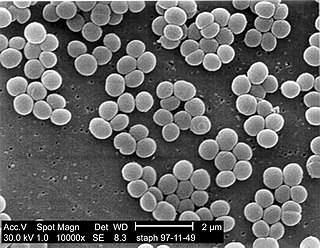Related Research Articles
The Gemmatimonadota are a phylum of bacteria established in 2003. The phylum contains two classes Gemmatimonadetes and Longimicrobia.
Mycobacterium boenickei is a member of the Mycobacterium fortuitum third biovariant complex. They are rapidly growing ubiquitous environmental organisms that normally inhabit soil, dust and water. These organisms frequently are human pathogens that cause a wide spectrum of clinically significant disease. It is important for practitioners to be aware of these organisms as possible etiological agents, as they are resistant to most first-line anti-tuberculous agents.
Mycobacterium chubuense is a species of the phylum Actinomycetota, belonging to the genus Mycobacterium.
Mycobacterium conceptionense is a non pigmented rapidly growing mycobacterium was first isolated from wound liquid outflow, bone tissue biopsy, and excised skin tissue from a 31-year-old woman who suffered an accidental open right tibia fracture and prolonged stay in a river. Etymology: conceptionense, pertaining to Hôpital de la Conception, the hospital where the first strain was isolated.
Mycobacterium haemophilum is a species of the phylum Actinomycetota, belonging to the genus Mycobacterium.

Mycobacterium kansasii is a bacterium in the Mycobacterium genus. It is an environmental bacteria that causes opportunistic infections in humans, and is the one of the leading mycobacterial causes of human disease after tuberculosis and leprosy.
Mycobacterium montefiorense is a species of bacteria which cause granulomatous skin disease of moray eels. Sequence analysis, of the 16S rRNA gene reveals M. montefiorense is most closely related to Mycobacterium triplex, an opportunistic pathogen of humans.

Cronobacter is a genus of Gram-negative, facultatively anaerobic, oxidase-negative, catalase-positive, rod-shaped bacteria of the family Enterobacteriaceae. Several Cronobacter species are desiccation resistant and persistent in dry products such as powdered infant formula. They are generally motile, reduce nitrate, use citrate, hydrolyze esculin and arginine, and are positive for L-ornithine decarboxylation. Acid is produced from D-glucose, D-sucrose, D-raffinose, D-melibiose, D-cellobiose, D-mannitol, D-mannose, L-rhamnose, L-arabinose, D-trehalose, galacturonate and D-maltose. Cronobacter spp. are also generally positive for acetoin production and negative for the methyl red test, indicating 2,3-butanediol rather than mixed acid fermentation. The type species of the genus Cronobacter is Cronobacter sakazakii comb. nov.

Staphylococcus is a genus of Gram-positive bacteria in the family Staphylococcaceae from the order Bacillales. Under the microscope, they appear spherical (cocci), and form in grape-like clusters. Staphylococcus species are facultative anaerobic organisms.
Macrococcus is a genus of Gram-positive cocci belonging to the family Staphylococcaceae. The genus was created in 1998.
Nosocomiicoccus is a genus of gram-positive cocci. The name is derived nosocomium - hospital; coccus from Greek noun kokkos - a coccus a grain, berry: Nosocomiicoccus - a coccus isolated in a hospital. The genus was erected in 2008. The genus is a member of the family Staphylococcaceae. A common feature of all members of this family is their osmo- and halotolerance - the ability to grow at high salt concentrations.
Macrococcus brunensis is a species of bacteria belonging to the genus Macrococcus.
Caldisericum exile is a species of bacteria sufficiently distinct from other bacteria to be placed in its own family, order, class and phylum. It is the first member of the thermophilic candidate phylum OP5 to be cultured and described.
Armatimonadota is a phylum of gram-negative bacteria.
Staphylococcus equorum is a gram-positive, coagulase-negative member of the bacterial genus Staphylococcus consisting of clustered cocci. Originally isolated from the skin of healthy horses, this species contains a cell wall similar to that of Staphylococcus xylosus.
Staphylococcus massiliensis is a Gram-positive, coagulase-negative member of the bacterial genus Staphylococcus consisting of clustered cocci. Strains of this species were first isolated from a human brain abscess and were found to be most closely related to Staphylococcus piscifermentans, Staphylococcus condimenti, Staphylococcus carnosus subsp. carnosus, Staphylococcus carnosus subsp. utilis, and Staphylococcus simulans. A subsequent study found that S. massiliensis may actually be part of the human skin microbiome and may have been a contaminant of brain abscess-derived samples.
Polynucleobacter is a genus of bacteria, originally established by Heckmann and Schmidt (1987) to exclusively harbor obligate endosymbionts of ciliates belonging to the genus Euplotes.
Macrococcus lamae is a species of bacteria belonging to the genus Macrococcus. Strains of this species were originally isolated from the skin of llamas.
Anaerococcus is a genus of bacteria. Its type species is Anaerococcus prevotii. These bacteria are Gram-positive and strictly anaerobic. The genus Anaerococcus was proposed in 2001. Its genome was sequenced in August 2009. The genus Anaerococcus is one of six genera classified within the group GPAC. These six genera are found in the human body as part of the commensal human microbiota.
Macrococcus canis is a Gram-positive bacterium from the genus of Macrococcus which has been isolated from the nose of a dog which had mucopurulent rhinitis in Switzerland.
References
- ↑ Mannerova, S. (1 September 2003). "Macrococcus brunensis sp. nov., Macrococcus hajekii sp. nov. and Macrococcus lamae sp. nov., from the skin of llamas". International Journal of Systematic and Evolutionary Microbiology. 53 (5): 1647–1654. doi: 10.1099/ijs.0.02683-0 . PMID 13130064.